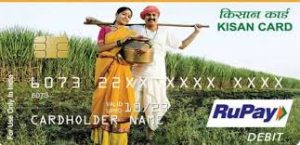KISAN CREDIT CARD- OBJECTIVES & REVISED FEATURES
Introduction
It is a credit scheme introduced in 1998, with aim to meet the comprehensive credit requirements of the agriculture sector. The scheme of KCC (Kisan Credit Card) was formulated by National Bank for Agriculture and Rural Development (NABARD) on the recommendations of R.V. GUPTA committee.
All the Regional Rural Banks, Cooperative Banks and Public Sector Commercial Banks are participating institution.

Objectives/Purpose
Kisan Credit Card Scheme aims at providing adequate and timely credit support from the banking system under a single window to the farmers for their cultivation & other needs as indicated below-
- To meet the short term credit requirements for cultivation of crops
- Post-harvest expenses
- Produce Marketing loan
- Consumption requirements of farmer household
- Working capital for maintenance of farm assets and activities allied to agriculture, like dairy animals, inland fishery etc.
- Investment credit requirement for agriculture and allied activities like pump sets, sprayers, dairy animals etc.
- KCC credit holders are covered under personal accident insurance scheme (PAIS) up to Rs.50, 000 for death and permanent disability, and up to Rs.25, 000 for other risk. The premium is borne by both the bank and borrower in a 2:1 ratio. The validity period is five years, with an option to extend for up to three more years.
Salient feature of Scheme
- All farmers who are eligible for the Kisan Credit Card will be issued a smart card cum debit card in addition to the Kisan Credit Card.
- The facility of revolving credit is available for any amount of withdrawals and repayments made within the credit limit. However, installments of the amount withdrawn have to be repaid within a year.
- Based on the annual review, banks will determine the validity and limits of the existing credit card.
- Credit limits can be enhanced by the bank to accommodate for changes in cropping pattern, increase in operating costs, etc. as an incentive for good record on credit card usage.
- Rescheduling of loans is also permissible in case of damage to crops due to natural calamities.
Who are Eligible
- All Farmers – Individuals / Joint borrowers who are owner cultivators
- Tenant Farmers, Oral Lessees & Sharecroppers
- SHGs or Joint Liability Groups of Farmers including tenant farmers, sharecroppers etc.
Fixation of credit limit/Loan amount (Based on Revised RBI Norms)
All farmers other than Marginal farmer, raising single crop in a year: Scale of finance for the crop (as decided by District Level Technical Committee) x Extent of area cultivated + 10% of limit towards post-harvest / household / consumption requirements + 20% of limit towards repairs and maintenance expenses of farm assets + crop insurance, PAIS & asset insurance.
Limit for second & subsequent year :First year limit for crop cultivation purpose arrived at as above plus 10% of the limit towards cost escalation / increase in scale of finance for every successive year ( 2nd , 3rd, 4th and 5th year) and estimated Term loan component for the tenure of Kisan Credit Card, i.e., five years.
Term loans for investments towards land development, minor irrigation, purchase of farm equipment and allied agricultural activities. The banks may fix the quantum of credit for term and working capital limit for agricultural and allied activities, etc., based on the unit cost of the asset/s proposed to be acquired by the farmer, the allied activities already being undertaken on the farm, the bank’s judgment on repayment capacity vis-a-vis total loan burden devolving on the farmer, including existing loan obligations.
Validity/Renewal
- Banks may determine the validity period of KCC and its periodic review.
- The review may result in continuation of the facility, enhancement of the limit or cancellation of the limit / withdrawal of the facility, depending upon increase in cropping area / pattern and performance of the borrower.
- When the bank has granted extension and/or reschedulement of the period of repayment on account of natural calamities affecting the farmer, the period for reckoning the status of operations as satisfactory or otherwise would get extended together with the extended amount of limit. When the proposed extension is beyond one crop season, the aggregate of debits for which extension is granted is to be transferred to a separate term loan account with stipulation for repayment in installments.
Security: Security will be applicable as per RBI guidelines prescribed from time to time. Security requirement may be as under:
- Hypothecation of crops up to card limit of Rs. 1.00 lakh as per the extant RBI guidelines
- With tie-up for recovery: Banks may consider sanctioning loans on hypothecation of crops upto card limit of Rs.3.00 lakh without insisting on collateral security.
- Collateral security may be obtained at the discretion of Bank for loan limits above Rs.1.00 lakh in case of non-tie-up and above Rs.3.00 lakh in case of tie-up advances.
- In States where banks have the facility of online creation of charge on the land records, the same shall be ensured.
Frequently Asked Question (FAQ)
KCC was introduced in:
It is a credit scheme introduced in 1998.
What is the objective of Kisan Credit Card (KCC)?
It aims at providing adequate and timely credit support from the banking system under a single window to the farmers for their comprehensive credit requirements (cultivation & other needs.)
KCC was introduced on the recommendation of:
The scheme of KCC (Kisan Credit Card) was formulated by National Bank for Agriculture and Rural Development (NABARD) on the recommendations of R.V. GUPTA committee.
Read more..
PM KISAN MANDHAN YOJANA
PM KISAN SAMMAN NIDHI YOJNA
PRADHAN MANTRI FASAL BIMA YOJANA
RASHTRIYA KRISHI VIKAS YOJANA
SOIL HEALTH CARD-AIM & BENEFITS
FULL FORM OF NABARD-ROLE & HISTORY
TYPES OF FARMERS-GOVERNMENT INITIATIVES
KRISHI VIGYAN KENDRA